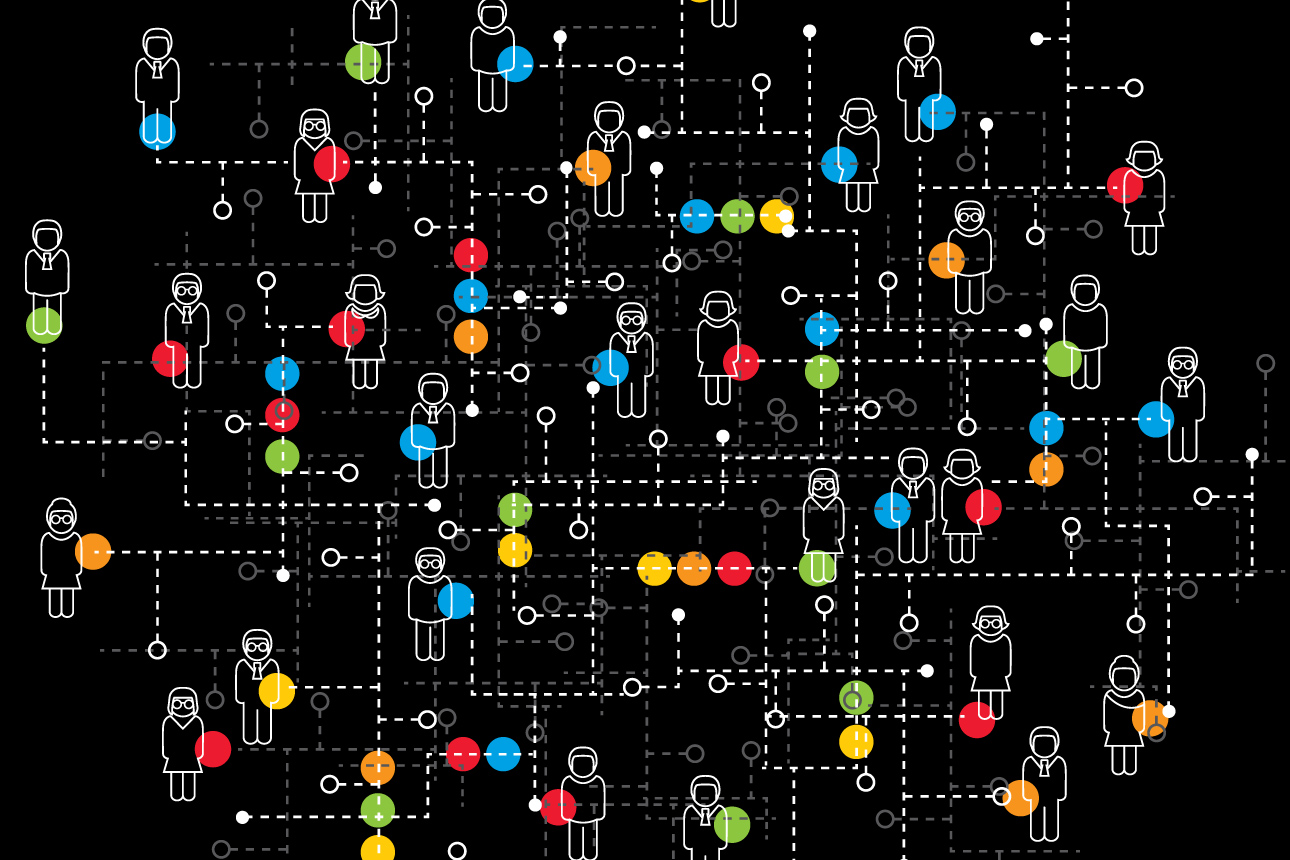Are You Ready to Lead Work Without Jobs?
We’re moving toward a system of work design that will profoundly change the roles of organizational leaders.

The way we have traditionally organized work and workers is becoming increasingly obsolete. We are moving toward a new work operating system that will deconstruct work into tasks and projects that may be assigned not only to employees but also to machines and contingent workers in talent marketplaces. In addition, workers will increasingly be identified not as holding a specific job but as possessing a set of skills and talents that can be applied wherever the organization may need them. These shifts were accelerated by the COVID-19 pandemic, which underscored the critical importance of organizational agility and flexibility — both of which are enabled by this emerging approach to work.
This will require a profound change in the mindset and behavior of leaders. This new way of designing work and organizing talent, as Ravin Jesuthasan and John Boudreau, coauthor of this piece, have previously described, requires managers to begin thinking in terms of how tasks and projects are accomplished, not how “jobs” are organized. It will require leaders and managers to become skilled at orchestrating a broad array of different resources — some human, some not; some employees, some not — to execute those tasks. And as talent gains greater agency to choose the most desirable projects and project leaders, the relationship between managers and workers will increasingly become less hierarchical.
Leadership Challenges of the New Work Operating System
When we have presented this idea to top leaders and HR professionals, they have correctly pointed out that work without jobs will require rethinking leadership, management, and work coordination. A typical reaction is, “I used to have four people in boxes called ‘jobs’ with reporting lines that ran to my box, and I could call on any or all of them to get things done within the mission of our collective job boxes. Now this new work operating system will in many cases dissolve the boxes. ‘My people’ become visible to other leaders through their deconstructed capabilities, and those other leaders can recruit my people for deconstructed tasks or projects.” They confront questions like these:
- When another leader has a task that matches the capabilities of someone who reports to me, how will we coordinate the assignment?
- How do I decide when to allow one of “my” direct reports to work on a task for someone else?
- How do I justify keeping direct reports without appearing to hoard them?
- How should I take account of the desires of the worker when deciding whether to consent to the request?
These questions point to the need for an evolved set of leadership and management competencies that better fit this new work operating system. And they foreshadow a significant shift in what it means to manage and lead successfully.
Changing Roles, From the C-Suite to the Front Line
Will the jobs of CEOs, C-suite executives, and leaders/managers also be deconstructed and reconstructed? Yes, eventually, but we will leave this question for a future article. The more immediate question is, how will the new world of work alter management’s responsibilities and priorities?
On the face of it, much will remain the same: C-suite leaders will still set the strategic mission of the organization and define standards, goals, conditions, and resources. This in turn will support functional leaders, who establish systems to align and support midlevel leaders, who in turn prioritize and translate organizational goals into strategic objectives for their units. And front-line managers will continue to define and prioritize the processes and tasks required to meet these objectives.
All of these managers will have additional vital roles in the new work operating system. One role will be to set the standards and boundaries of the new work operating system, particularly when organizations are at the early stages of the transition. Not all work is best done in a deconstructed way, and the speed with which organizations adopt an approach of deconstructing jobs will vary based on their mission, strategy, processes, culture, and technology, among other factors.
The second vital role for high-level functional leaders will be to set the broad guardrails that define how work is both delineated and coordinated across functions. Functions such as finance, operations, facilities, legal, medical, HR, and IT will each establish certain boundaries and principles about how work is accomplished, coordinated, and shared. Currently, those guardrails are generally set when an individual takes a job: For example, workers are granted access to certain IT systems, clearances to handle sensitive materials, or even the rights to enter facilities that require health and safety training. But as jobs are deconstructed into sets of capabilities or tasks — which could potentially be done by a wider variety of people, including non-employees — setting and adapting these guardrails will have to be done quickly and continually and will require rapid cross-functional coordination. New ways of organizing and assigning work will demand that the high-level leaders of an organization give increased attention to the work and how it is accomplished and shared. There has to be an underlying accepted model for how power and accountability are distributed — and it must also evolve in step with how the organization adopts tools like internal talent marketplaces. This is the key to avoiding chaos and ensuring that the new work operating system remains consistent with the broader strategy, purpose, and culture that defines the organization.
Meanwhile, front-line leaders will still organize and optimize the goals of their units and attend to the needs and desires of their workers, but now in the currency of tasks and projects, and worker skills and capabilities. They will evolve into project leaders who perpetually deconstruct projects into tasks and assemble workers into teams to accomplish those tasks based on their deconstructed capabilities. In many cases, workers will no longer be exclusively assigned to a leader through a stable job and hierarchy. In organizations that adopt “work without jobs” fully, the work and workers will be more free-floating, and leaders and managers will quickly assemble and disassemble teams to achieve the broader unit and organizational goals.
All of this will result in fewer places for leaders to hide and more opportunities to be seen. Leaders and managers will be defined less by title and credentials and more by achievements and character: What have they done? How have they done it? What are they capable of doing? As we consider the new operating system further, it calls for strengthening and adapting some traditional leadership skills and building some new ones.
New Leadership Competencies for Work Without Jobs
Of course, leadership has always meant creating conditions for organization members to make their best contributions, but the new work operating system fundamentally changes how. Here are some of the required capabilities and approaches for future leaders and managers in a system of work without jobs:
From digital savviness to technological fluency. In the new work operating system, deconstruction and reconstruction that combine humans and automation will require leaders to perpetually anticipate how technology and automation affect work. That means constantly balancing new innovations with viability and practicality and explaining new combinations of human and automated work to employees. Decisions about whether automation will replace, augment, or reinvent human work will need to be made continually at the task/project level — and will have to reflect an up-to-the-minute understanding of technological capabilities.
From process execution to project guidance. The organization will become a landscape of ongoing and evolving projects rather than a collection of defined and organized processes. Managers will constantly source talent within and beyond the traditional organization and rapidly assemble teams based on required skills and capabilities. Knowledge workers will more often connect with projects virtually through technology, so this evolved project management will more prominently reflect automation, distance collaboration, and influence. In traditional systems, such project management and coordination might be accomplished by aligning tasks to Gantt charts, for example, but the new system will require more real-time and perpetual coordination. Managers will continually apply tools much like those now used by agile teams (such as scrums, sprints, and hacks).
From hierarchical authority to empowerment and alignment. Hierarchical authority will be inadequate in the new system of work without jobs, because workers will not be as tied to traditional reporting structures, and project-based work requires teams to increasingly self-manage. The transparency of the new system will make work opportunities more visible through a continually updated array of options available to workers. Employees will demand more work that meets their personal preferences and seek the freedom to shift from project to project. Leaders will need to set strong frameworks that balance worker empowerment with accountability and consistency that reflects the broader task/mission. They will have to discern when and how to negotiate, whether to negotiate formally or informally, and how to attain team and individual alignment about how value will be created and shared.
From technical to humanistic work automation. Work automation requires work without jobs because optimal solutions are often visible only at the task and skill levels. We will have more frequent, and visible, choices to make between replacing, augmenting, and reinventing the human worker — in the latter case, by using technology to give humans entirely new and more valuable capabilities that are possible only through automation. Such decisions will no longer be episodic, discussed in the context of a new robot or AI system, but rather will be a perpetual series of decisions by leaders and their teams. One issue that will gain prominence is potential bias when choosing whether tasks are done by human workers or machines/automation. Leaders may assume that automation always produces greater predictability and efficiency, but as such choices increasingly occur at the project level, managers will need a more nuanced understanding of what humans can contribute in aesthetic creativity, cultural perspective, and innovative potential.
From episodic to continual focus on diversity, equity, and inclusion (DEI). The traditional job-based system inclines leaders to consider DEI episodically, typically when hiring or considering promotions. As important as these opportunities can be, it is the ongoing relationships and interactions that more often determine DEI success. A system of work without jobs puts the focus squarely on these ongoing interactions and presents far more frequent opportunities to choose, assign, reward, and develop team members, because tasks/projects and team memberships are fluid and perpetually reinvented. This could significantly enhance DEI efforts by offering more opportunities for new work experiences than traditional job-based systems afford. Yet, if bias persists, that same accelerated frequency can result in more noninclusive choices. Organizational leaders will need to create new processes for continually assessing whether work, and its remuneration, are distributed equitably.
The Foundational Pillar: Purpose-Led Work
In sum, the success of a system of work without jobs will rest on leaders and managers who consistently lead themselves and others with purpose. The essence of this change is distilled into a question posed by Robert Goffee and the late Gareth Jones: “Why should anyone be led by you?” This question becomes even more important as human talent gains agency and autonomy to choose work from platforms in service of serial teams and multiple leaders.
Real-time leadership and management in a system of continually reinvented work means rethinking fundamentals such as attracting, retaining, motivating, and engaging workers. Talent will choose projects based on the desirability of the task (“What will I do?”) and also the “brand” of the leader (“How will I be led?”). To continually and successfully assemble teams in the new work operating system, leaders must nurture their now more-transparent leadership brand and track record.
We already see this in organizations that track and codify leader/manager quality on internal talent marketplaces. Employees have ready access to a leader’s leadership brand across projects on the platform. This brand will be revealed in the shadow leaders cast from their past projects and will be embodied in marketplace ratings by former team members that address a range of questions, such as “How much can you learn by working with them?” and “How open and flexible are they to innovation and different styles of work and contribution?” In a traditional job-based system, such questions are answered only obscurely and indirectly.
The new system may embody something like a perpetually updated Leader Net Promoter Score (NPS), calculated as the percentage of promoters minus detractors based on the question “How likely are you to recommend us to a friend or colleague?” Today, NPS is a common tool to assess customer satisfaction, and the new work operating system could easily adapt the tool for leaders. The new system will make it acutely obvious how they are seen by followers who perpetually engage and reengage, much like customers who have repeated service or product experiences.
With leaders’ reputations continually earned and confirmed via their project track records, they will have dramatically less lead time to effectively and inspirationally convey who they are and what guides them. As workers travel a career path of fast-changing tasks/projects and roles, working serially for new project managers, they will increasingly discern which leaders share their higher aspirations for value beyond task success. The increased speed and granularity of work without jobs will prize leaders whose purpose is like the keel of a sailboat, steadying and guiding it toward a destination even as it tacks through shifting winds. Leaders who convey such sustainable purpose will be the ones best able to attract necessary talent.
Upon first encounter, the new work operating system can seem to diminish the human dimension. However, work without jobs will actually enhance the impact of leaders’ humanity, differentiating good from great organizations. Organizations that thrive will rely more on leaders and managers who are capable of assembling, selecting, assessing, developing, motivating, and articulating purpose and alignment for short-term teams formed by deconstructing and reconstructing work and workers. This new agile, serial leadership will require leaders and managers to excel at human leadership as they perpetually reinvent work; construct more transient, deconstructed, and highly efficient teams; and blend humans with technology.








